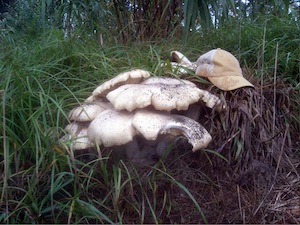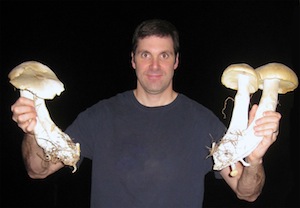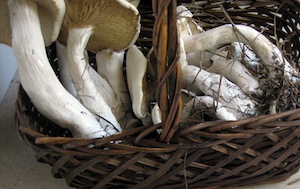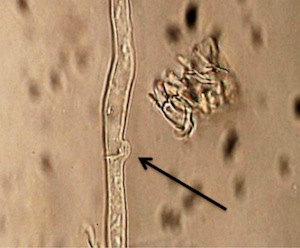 Fig. 1. Cluster of mature M. titans mushrooms in Athens, Ga., in October 2012. An adult-size baseball cap was placed in the background for scale. (Photo courtesy of Kirk Edwards)
Fig. 1. Cluster of mature M. titans mushrooms in Athens, Ga., in October 2012. An adult-size baseball cap was placed in the background for scale. (Photo courtesy of Kirk Edwards)Macrocybe titans is the largest gilled mushroom of any species in the Western Hemisphere, with caps in excess of 100 cm (3 ft). These giant mushrooms often occur in clusters within the tropics and subtropics of the New World, with previous sightings reported in the Caribbean, Central America, Mexico, South America, and only in Florida within the USA. Confirmation of this species in Georgia now extends the previously known range of M. titans. To our knowledge, this is the first report in Georgia. The mushrooms were discovered in October 2012 in the yard of an abandoned house in Athens. The fungus was identified as M. titans based on morphological features, habitat where it was found and DNA sequence similarity with known specimens.
The large, cream to buff-colored mushrooms were found growing in three large, dense clusters of eight to 10 mushrooms each (Figure 1). Single caps were 20-30 cm (8-12 in.) across and convex with incurving at the margin. Younger mushrooms (Figure 2) had more convex caps than those of older specimens that became flattened with age. The smooth, dry surfaces of the caps were cinnamon-buff in color at the crowns fading to cream toward the margins. The inner flesh of the caps was white. The spore print, which was obtained by placing a cap on half white and half dark-colored paper and covering it with a bowl overnight, was creamy white (spore prints are necessary for proper mushroom species identification).
 Fig. 2. Cluster of young M. titans mushrooms in Athens, Ga., in October 2012.
Fig. 2. Cluster of young M. titans mushrooms in Athens, Ga., in October 2012.The stipes (stems) of the mushrooms were cream to buff measuring 30-45 cm (12-18 in.) in length (Figure 3). They were club-shaped, tough and fibrous with bent-back scales and striations that curved around the stipe like stripes on a candy cane. The dense clusters of mushrooms were formed by the attachment of individual stipes at the base. Several miniature mushrooms less than 2.5 cm (1 in.) in height were found attached to the base of the clusters. The cream to dull-yellow gills of the mushrooms were wavy, crowded and attached to the stipes (Figure 4).
Microscopic observations of the filamentous fungal tissue (hyphae) from the cap showed that clamp connections were present where cells were joined (Figure 5). Clamp connections are diagnostic for the genus Macrocybe. Other important structures for identification, including the spore-producing basidia and sterile pseudocystidia, could not be observed due to deterioration of the gill tissue.
 Fig. 3. Mushrooms from clusters of M. titans collected in Athens, Ga., in October 2012.
Fig. 3. Mushrooms from clusters of M. titans collected in Athens, Ga., in October 2012.The species of the mushroom-producing fungus was confirmed as M. titans by sequencing a region of its DNA. DNA was extracted from tissue inside the cap of one of the mushrooms by using a commercially available kit (DNeasy Plant Kit, Qiagen). The large subunit of the ribosomal DNA (LSU-rDNA) region was amplified by the polymerase chain reaction (PCR) using the universal primers NL1 and NL4. The PCR products were sequenced in both directions at the Georgia Genomics Facility in Athens, Ga. The sequences were aligned and visually edited in the program Geneious R6 (Biomatters, Ltd.). Our consensus sequence (deposited in GenBank, accession no. KC913200) was most similar based on BLAST analysis with 99% identity to the sequence of a known specimen of M. titans (accession number U86437) in the publicly accessible sequence database GenBank.
 Fig. 4. Specimens of M. titans collected in Athens, Ga., in October 2012 showing wavy, cream to dull-yellow gills and scaly, striated stipes.
Fig. 4. Specimens of M. titans collected in Athens, Ga., in October 2012 showing wavy, cream to dull-yellow gills and scaly, striated stipes.The mushrooms of M. titans, like the fruiting bodies of any fungus, are the reproductive structures where the spores are produced. The majority of the fungus is actually growing as filamentous hyphae underground and out of sight in decomposing dead and decaying plant matter in the soil. The three nearby clusters that were observed likely came from a single individual growing in the soil beneath the tall grass. M. titans is saprotrophic, which means that it decomposes dead or decaying plant matter and does not cause disease or rot on living grasses or trees.
It is not clear why or how this fungus found its way into Georgia. The mushrooms were close to landscape ornamental grasses and it may have arrived with the container plants, as Florida is a large producer of ornamental landscape plants. Or, it may be expanding its geographic range into Georgia due to climate warming or some other factor. This species was previously known as Tricholoma titans, but in 1998 was renamed Macrocybe titans, which literally translates from Latin into “giant large head.” The mushrooms are reportedly edible; however, never consume a wild mushroom without identification confirmation by an expert. Contact your county Extension office should you happen to encounter the giant mushrooms of M. titans.
 Fig. 5. Clamp connection in hyphae of M. titans (400X magnification). The clamp is at the tip of the arrow and is to the right of the septum.
Fig. 5. Clamp connection in hyphae of M. titans (400X magnification). The clamp is at the tip of the arrow and is to the right of the septum.We thank Kirk Edwards for discovering these mushrooms and contacting us about their identification.
References
Bessette, A. E., Roody, W. C., Bessette, A. R., & Dunaway, D. L. (2007). Mushrooms of the Southeastern United States. Syracuse University Press.
Bigelow, H. E., & Kimbrough, J. W. (1980). Tricholoma titans, a new species from Florida. Mycotaxon, 11(2), 425–429.
Pegler, D. N., Lodge, D. J., & Nakasone, K. K. (1998). The pantropic genus Macrocybe gen. nov. Mycologia, 90, 494–504. https://doi.org/10.1080/00275514.1998.12026934
Status and Revision History
Published on Aug 27, 2013
Published with Full Review on Mar 28, 2017
Published with Full Review on Sep 03, 2019
Published with Full Review on Feb 28, 2024


























































